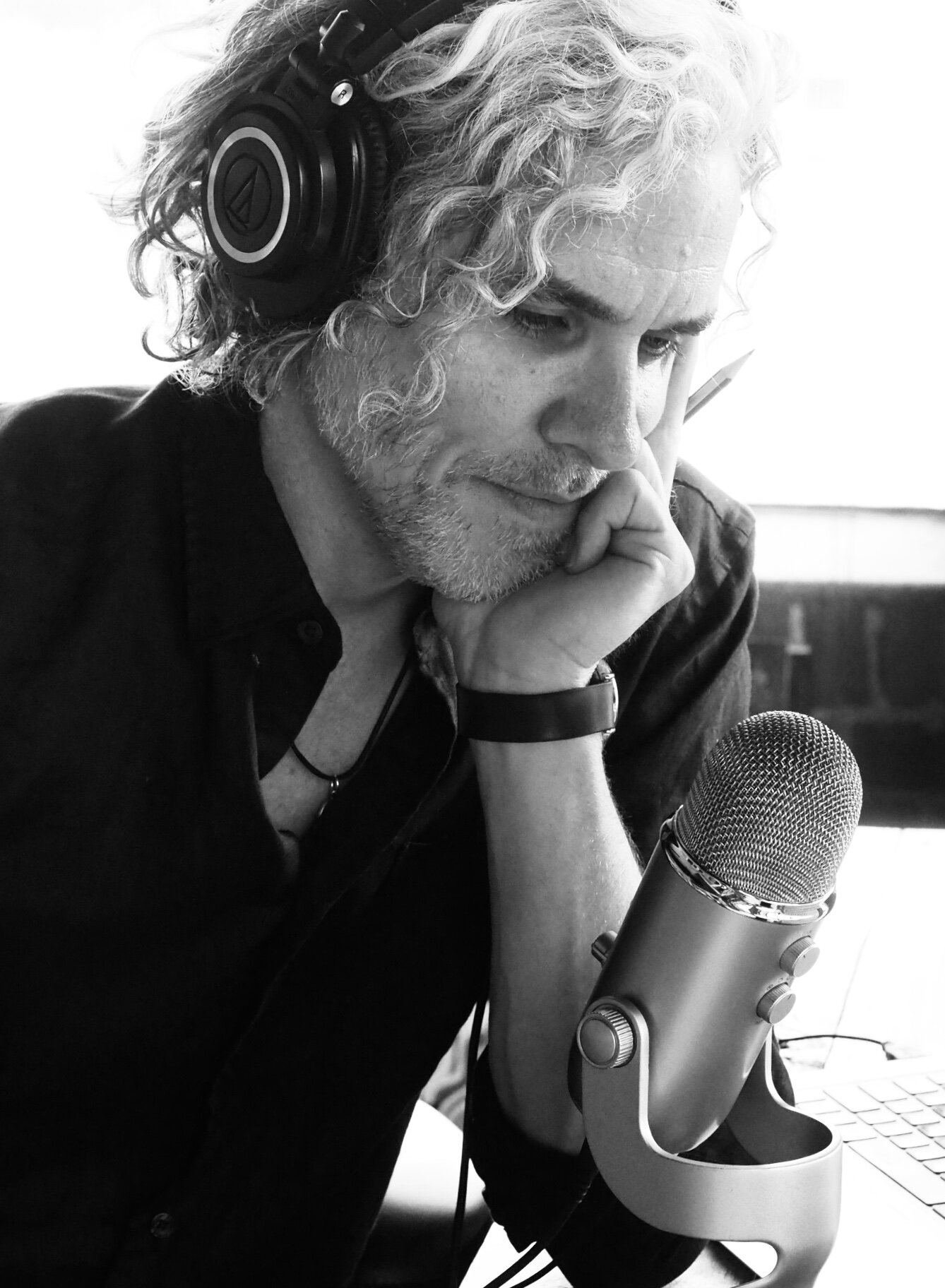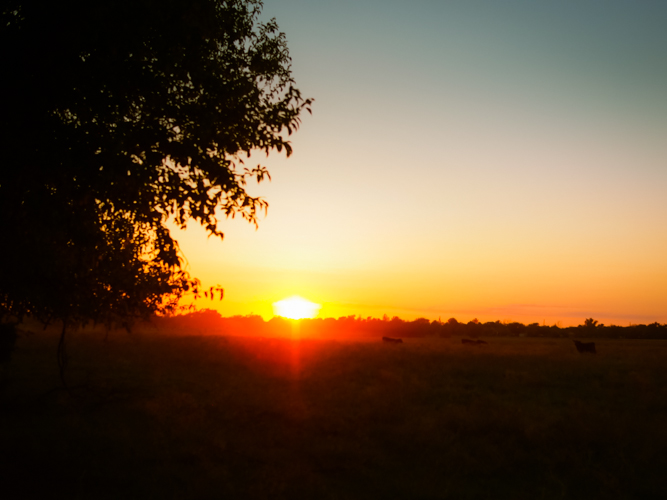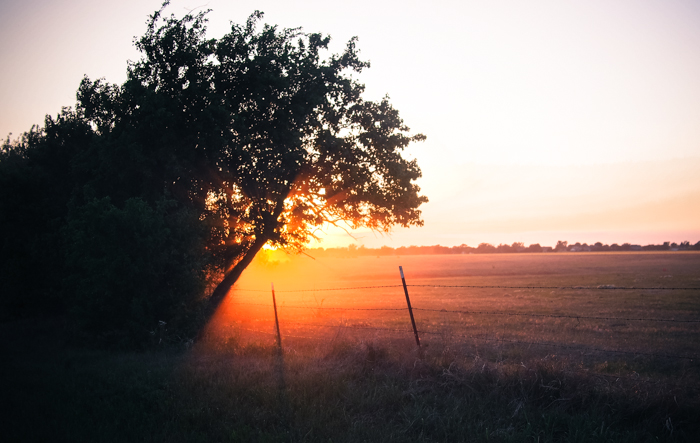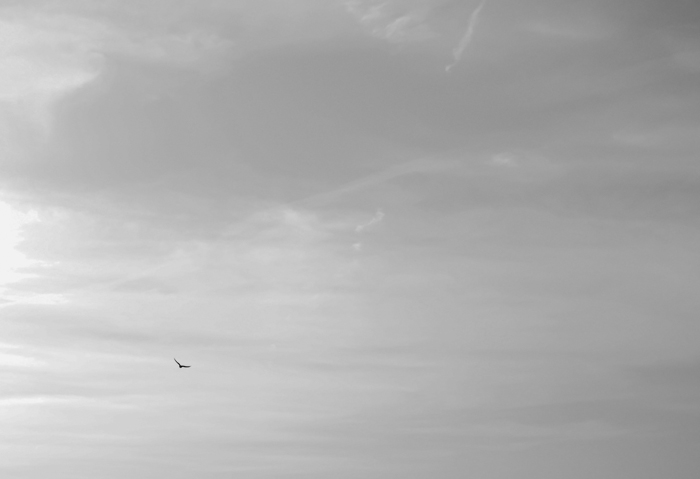 I saw the ‘No Tresspassing’ sign but hopped the fence despite the blaring placard. The bridge, its dignified bearing and iron carapace, was simply too beautiful to resist.
I saw the ‘No Tresspassing’ sign but hopped the fence despite the blaring placard. The bridge, its dignified bearing and iron carapace, was simply too beautiful to resist.
The moment my feet hit the ground, I saw him. He was on his tractor and turned the corner, just as the swing of my momentum gave way to solid terrain beneath me. We locked eyes. Hunter-with-camera became suspect-with-panic. His stare fell to my shoulder, spying the camera slung across my back. His eyes squinted a smile at me as he gave me a thumbs up (the universal sign for 'I won’t shoot you'). I gave him a vertical pollex back and chased it with a matching (alleviated) grin.
After taking a few snaps, I descended the steep declination of rock and dirt, looked back over my shoulder, and waved an enthusiastic farewell. The gleam of his teeth and the squint of his eyes shone through the opaque tractor glass but it was his magnanimous spirit I felt as we parted, a concomitant with the spirit of the grand old ironwork.
Rambling my way back from Paris, TX, I was hang-dog bummed my camera had not shuttered anything remotely salient. It was midday, middle-of-May heat. There would be no 'magic hour' evening tints to bolster my lackluster photog skills, at least not for a few hours. But the vertical sunrays did not prohibit me from trekking a few gritty roads, threading my way on one solitary ribbon of dirt for at least twenty miles. Midway along the traildrive, I shut off the engine, pausing to listen to the wind cascade through the redolent cedars.
Spring had sprung. Trees popped with winged delights, the only sounds: random interludes of warbles and chirps plus the occasional whir of grasshoppers. Despite flaring allergies, I enjoyed being lost. The middle of Nowhere, TX suits me just fine. Crawling toward blacktop, the final drive home, I cruised a snail’s pace, windows open, a Texas playlist of padres crooning in my ear. Eventually, I slugged my way back onto familiar terra firma, Mustang Road. A mere four miles from home, the magnanimous sky unfurled a maddening lavender and liquid orange canopy. I grabbed my camera: point, shoot. A child could have snapped this picture. Proving, once again: Landscape photographers receive far more credit than they deserve.
Dust storms spume from the earth’s belly frequently in Oklahoma. Steinbeck wordsmithed this story in The Grapes of Wrath. The shot above and photo below capture, not mist, but dust as it slowly settles after the freshly plowed thunder of hooves.
Often, when I run, I take along the same accoutrements cowboys carried along with them on the infamous cattle drives nearly 130 years ago: Hat, special shoes, and spurs. (Okay, maybe a trail shoe with tread isn’t the same as boots and spurs but it does keep the beast of burden moving). The special pants (alright, tights) a far cry from chaps, but similar in that tights protect from the bite of winter weather and chaps from the chafe of briars and thistles (yeah, I know ... that's a stretch, -pun painfully intended-). But above all, the one article that has remained constant, with little-to-no change in material composition or function, is the trusty bandana. The cowboy's bandana, a versatile accessory, was used as a mask to keep out trail dust and as insulation against the sun (cowpokes would stuff it inside their hat, much like we insulate beneath the roofs of our houses). The bandana also was a critical part of the medicine chest as tourniquet.
The wind frequently roils to above 30 MPH here, scraping the thin, top layer of detritus from the rolling hills, rendering it an asperity of nature, nigh untenable for man and beast. I can only imagine riding what the cowboys referred to as 'drag', the last position in a column of cowboys, 'dragging' behind 3,000 head of cattle and beneath a blazing furnace of sky. Occasionally, you’ll encounter the dusty whirlwinds from the safety of an enclosed vehicle. They are fascinating to watch, like dust devils, the Navajo’s chiindii, spirits of the dead. As with hurricanes, the dust storms tend to take on an epic personality all their own. I frequently pull my bandana from my forehead to cover my mouth and nose to avoid the friable whirling dervishes or simply to keep from inhaling the sweeping, fetid aroma of fresh road kill (unpleasant thought, I know, but it’s a fact of life in a farm community, particularly around springtime). I also imagine, for a brief moment, what it must have been like, ranging across this vast prairie astride thousands of beasts of burden, the dangers of the work before me, the home I left behind me, and the hope of comfort to come.
I saw this flash of light and thought of Willa Cather's piquant prose in her novel, Death Comes for the Archbishop. "The light was full of action and had a peculiar quality of climax - of splendid finish. It was both intense and soft, with a ruddiness as of much-multiplied candlelight, an aura of red in its flames. It bored into the ilex trees, illuminating their mahogany trunks and blurring their dark foliage ...".
Yesterday, on a quick 3-mile ramble, I stumbled past a tree with a red-winged blackbird perched atop. The tree sat rooted opposite this windmill (pictured above and below). The bird (one the Lakota calls wablosa, 'wings-of-red') remained stationary, despite my approach. Normally, birds fever skittishly as I move toward them with my camera (I only carry 45mm or 20mm pancake lenses for obvious tote-ability; no long lenses, this makes long shots impossible but forces me to move within nature for close-ups).
I hobbled past the tree, curiosity peaked as to why this solitary figure remained immobile when a hawk suddenly flushed from hiding (hawks hide in plain sight, their plumage, brilliant camouflage against the backdrop of dusky prairie). Clambering skyward, the hawk was swiftly tailed in a thunderous wake by two smaller birds: one, the red-winged blackie and the other (blackie's mate) a smaller, brownish blackbird.
An aerial dogfight exploded, vociferous and violent. The smaller birds beat round the hawk mid-air, dive-bombing in and out of its path, wings flapping furiously in brutal assault. The tiny passerines seemed to tackle the hawk, at times appearing as one bird, their clash fought in such close quarters, breaking; buckling, parting; slamming together again. They all but plummeted to the ground. The raptor sliced the air, harvesting light and air in expansive but ferocious swaths. The attackers abated only when the hawk reached a safe distance from the blackbirds' territory. I read later that a red-winged blackbird's hardihood is due to its fierce protectiveness. Crows, ravens, hawks, raccoons, minks, foxes, snakes: the red-winged blackbird remains undaunted because it sees every intrusion as hostile, every adversary in hunt of a quarry, the quarry being the offspring nesting in the nearby grass.
'His wing / Scythes down another day, his motion / Is that of the honed steel-edge, we hear / The crashless fall of stalks of Time.' - Robert Penn Warren, 'Evening Hawk'.
Head on a swivel, that's how I run, an Olympus E-PL5 strapped to my back, my head pivoting side-to-side (often, out-motoring my legs). Since I started trying to see beyond the commonplace, I have learned to instinctively frame as I pass particular 'scenes'. Just as a director frames a shot with his hands to gain perspective on how the portrayal will look to the audience, so, too, a photographer frames before actually shuttering his camera. I run past this ranch frequently but only this time saw what seemed like a French impressionist's depiction of farm life. The tree, in particular, looked slightly Renoired, a scene Monet might find himself perched beside.
According to A. E. Hotchner, when Hemingway first landed in Paris, he claimed that certain paintings taught him how to write. I believe this. No other medium bears such concentration, its canvas depicting a scene immutable but still conveying a story, multifoliated and continuous. Probably to my discredit, I have learned to appreciate nature more from the drips and strokes of a painter's palette and brush, than I have from nature herself.
I often share my pics on Instagram first, getting a feel for what friends think about various compositions. The response to this shot intrigued me. I don't have many followers but the majority of those who frequently respond to my photos reacted favorably to this one. What was so intriguing about this shot? Fence in rustica? The backdrop of billowing canvas? The imminent storm gathering on the horizon? Or was it the beautiful simplicity of a pastoral moment? 'A mirror may not reflect mind, but a man's response to landscapes ... does.' - William Least Heat-Moon (paraphrasing Walter de la Mare), Blue Highways.
The sky is rarely parsimonious. On any given day of the week it will unfurl in cerulean splendor, like in this photo. 'In this world of ours beauty is quite common', writes Borges.
Plagued with a terrible memory, I do get impressions of remembrances, vague notions at times: I've seen this before. Or Deja vu intuitions: I've been here before. Often, where I think I've been is actually what I've read, mental images carved along memory traces by words. An occasional glimpse of a landscape casts me back to a book I've read, to hunt the impression in detail. This photo compelled me to my library, to the words of Joseph Conrad. I recall a brooding beginning in of my favorite stories, Heart of Darkness. The story begins with the ship Nellie anchored on the Thames, before its famous voyage. The anonymous narrator begins, prose effusive with admiration at the waterway before him, "Forthwith, a change came over the waters, and the serenity became less brilliant but more profound. The old river in its broad reach rested unruffled at the decline of day, after ages of good service done to the race that peopled its banks, spread out in the tranquil dignity of a waterway leading to the uttermost ends of the earth. We looked at the venerable stream not in the vivid flush of a short day that comes and departs for ever, but in the august light of abiding memories."
The Paseo District, Oklahoma City, OK.










